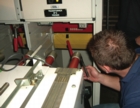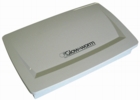2009 February
MBS and Cerebra sound out the industry on key issues and salaries
Between September and December 2008, Modern Building Services, in association with Cerebra Recruitment, carried out a reader, industry and salary survey. Hundreds of people took part from all areas within the industry and of all levels of experience and seniority. The results are summarised in this special report.
Not only is the North London Data Centre of Fujitsu the only fully certified Tier III data centre in Europe but it also has less than half the M&E services energy consumption of standard designs of such buildings — thanks to an holistic design approach by consultants Red Engineering Design.
The Tier classification system for data centres, there are four levels, has been devised by the The Uptime Institute of the USA to define performance standards such as redundant capacity, distribution paths for data communication and the effect of maintenance work.
Tier II, and Tier III, require N+1 active capacity equipment such as chillers, pumps etc. to support the IT load.
Tier III, unlike Tier II, also requires each and every piece of equipment such as an entire chiller, pump or an individual valve, to be maintainable or replaceable with no disruption to the operation of the centre. Also, unlike Tier II, Tier III requires two distribution paths for power and cooling and data, both within the centre and with the outside world.
Also affecting the design of a Tier III data centre is on-site generation being regarded as the primary source of electrical power — which has been addressed in a novel way on this project.
The level of energy efficiency achieved at Fujitsu’s North London Data Centre, for which the overall build and fit-out costs were approximately £44 million, and the high operational integrity required might seem incompatible. However, Lee Prescott of Red Engineering Design does not see it that way at all.
Having more chillers, pumps and other equipment than required to meet the design load enables, with the aid of inverter control of motors and compressors, more equipment to be run at part load rather than less at higher loads. The square laws and cube laws that apply to fans and pumps then come into their own to reduce energy consumption.
Red Engineering Design also thought very carefully through all energy-usage patterns to reduce overall energy consumption. One example, of which more below, is the use of heat pumps drawing energy from the chilled-water return, which will have absorbed heat from the servers, to supply heating coils in the air-handling units — reducing the heat to be rejected and the load on the chillers.
A generally accepted definition of the energy efficiency of a data centre is the PUE (power usage effectiveness), which compares the total energy use of the site with IT power requirement. Total energy use being double that of the IT equipment is regarded as good. Most data centres achieve 2.3 to 2.6. The Fujitsu data centre has been designed to a design day PUE of 1.41 with an annual average PUE, taking into account free cooling, of 1.27 .
The cooling strategy is based on chilled water to computer-room air-conditioning (CRAC) units with heat rejection using cooling towers. The more common approach is direct-expansion units in the data halls or chilled water with air-cooled chillers, perhaps with free cooling.
Lee Prescott explained that as long as a strict maintenance regime is in place the use of cooling towers for heat rejection poses no risk to the operational resilience of this data centre.
The centre was previously a single-storey warehouse and a 2-storey office complex. It has been refurbished to provide technical space comprising six data halls, two comms rooms and a build room.
The initial study was based on an average IT load density of 750 W/m2, and the base engineering systems have provision for high-density equipment to 20% of the data halls with a load density of 1500 W/m2.
Chilled water for the M&E infrastructure is provided by three McQuay chillers using R134a and having variable-speed drives. Only two chillers are required to meet the load, so there is N + 1 redundancy — which is exploited by running all chillers at part load to improve energy efficiency. A failed chiller would automatically be isolated from the chilled-water system.
Heat rejection is via three Marley open-circuit cooling towers. To ensure continuity of operation if the mains water supply should fail, sufficient water is stored for at least three days at peak summer load.
Chilled-water temperatures are higher than usual practice to increase cooling plant efficiency and maximise the potential of free cooling.
Lee Prescott explains that the heat-rejection capacity of a cooling tower depends mainly on the wet-bulb temperature, rather than the higher dry-bulb temperature, so water leaves a cooling tower at a lower temperature than from a dry cooler. The leaving condenser water temperature varies, depending on ambient conditions, enabling the chillers to achieve COPs of up to 14.8. The water cooled chillers are selected carefully to still achieve a minimum COP of 8 even during design-day conditions. This compares with 3 to 3.4 for a typical air-cooled chiller. In addition, more air- cooled chillers would be required and need more space. Relatively high flow/return temperatures are used because most of the heat in the data rooms is sensible, so there is no requirement for dehumidification.
A plate heat exchanger connected to each chiller, the cooling towers and the CRAC circuits provides the means of delivering free cooling — both total and partial.
Whenever condenser water from the cooling tower is colder than the return water from the data halls, there is the opportunity for free cooling, which is available for over 50% of the year.
The free cooling, which is under the control of the Trend Building-management system, is an extremely efficient and cost-effective engineering solution compared with large banks of separate free-cooling plant. The efficiently produced chilled water is also used efficiently by the CRAC units. These units deliver cooled air downwards into the floor void, from where it exits into the cold aisles. Return air passes into the top of the CRAC units, which have a ‘collar’ on top to increase their height so that the return air is at a higher temperature — increasing heat-exchange efficiency.
The performance of the CRAC units is matched to the load using variable-speed secondary chilled-water pumps and a 2-port control valve. Less water is pumped round the system, significantly reducing the energy consumption of pumps.
Similarly, the CRAC units have variable-speed fans so that to meet maximum load fans in all units, including redundancy capacity, can run at reduced speed. The fans also reduce in speed if the data centre is operating at low load.
All the technical spaces have a separate conditioned supply of fresh air from two (N+N) air-handling units to pressurise these spaces and improve cleanliness by preventing the ingress of particles of dirt and dust.
Heating for the fresh air is provided by three Dynaciat water-to-water heat pumps. Two can meet the requirement, so there is one redundant heat pump (N + 1). The energy source for these heat pumps is the return chilled water — a proportion of the flow is drawn off. Water for heating comes off at 50°C. Lee Prescott explains that the only cost of generating this heat is due to the lower efficiency of the heat pumps compared with the main chillers.
The CRAC units operate with a sensible cooling ratio of unity, and all the latent heat is in the fresh air. The fresh air humidification requirements are met by cold-water atomised-spray humidifiers from JS Humidifiers. While the capital cost is higher than an electrode-boiler system, the energy costs are much less. The only energy required is electrical power for the air compressor and booster pump. Water is treated using silver ions. This method of humidification is adiabatic, which has a cooling effect, so the supply air may sometimes need preheating. The pre-heating is sourced from the heat recovery systems.
Security of power supply is vital in a Tier III data centre. There are two incoming 11 kV supplies, either one of which can meet the centre’s requirements of 7.5 MVA. There are two separate substations for the mechanical plant, again for security of operation.
In the event of a total failure of the mains supply, there are six Diesel Rotary Uninterruptible Power Supply units (DRUPS) in N+2 configuration, with space for a future seventh unit) to meet the total load — including all mechanical services. The DRUPS standby engines are fuelled by diesel, and there is sufficient stored on site to cover a three day bank-holiday weekend.
Batteries are not used to cover the break in supply between the mains failing and the standby engines taking over the load. Instead the DRUPS system is used (diesel rotary uninterruptible power supply). Mains power keeps a kinetic energy store spinning, which in turn, drives an alternator. If the mains fails, the kinetic energy store keeps the alternator turning while the diesel engine starts and runs up to speed before taking up the drive.
The environmental control of the office areas will be much more familiar. Daikin VRVIII equipment provides energy-recovery heating and cooling, so that some areas can be cooled at the same time as others are heated. The fresh-air supply for the offices is controlled to meet the requirement using carbon-dioxide sensors to monitor air quality.
The aging boiler and its associated perimeter heating system have been removed, and domestic hot water is now provided by point-of-use electric water heaters.
The team at Red Engineering Design have designed a large number of data centres in the UK and overseas, the North London Data Centre of Fujitsu of which is the most sophisticated. Not only is its projected energy consumption, for the supporting M&E services, less than 40% of a conventionally serviced centre but at a cost less than the minimum rule of thumb £/m2 figure for a Tier III facility.
The facility has been awarded ‘Most sustainable refurbishment’ in the BSJ Sustainability awards, something the whole team is very proud to have achieved. The project has also won an award for Innovation in the Mega Data Centre from Data Centre Dynamics.

HVCA acknowledges outstanding service
John Hunt, formerly of Axima Building Services, and Stuart Lyon of MITIE Engineering Services (Scotland) have received HVCA outstanding-service awards.

Trox enjoys growing export success for MSCBs
Trox’s success with multi-service chilled beams in the UK is spreading overseas, as evidenced by orders for 15 export projects with values from £30 000 to over £2.5 million.

Buderus takes more control of commercial boilers
Buderus has increased its range of energy-saving controls for commercial boilers with the MCM10 intelligent sequencing module. Designed for Buderus multiple-boiler systems such as the GB162 range, this multi-cascade module offers additional control operations, simplifies operating functionality and minimises fuel consumption.

Preformed base for wetroom showers is easy to install
Purus has introduced a preformed base for wetroom showers that is easy to install. The Maxxus wetfloor former is designed to facilitate level-access showering on timber or concrete flooring in a variety of formats up to 1500 x 800 mm.
HETAS has published a new version of its definitive guide for the solid-fuel and biomass industry.

Armstrong’s dedicated product micro-sites
Armstrong, which supplies high-efficiency HVAC and fluid-handling equipment for residential, commercial and industrial applications, has added two new micro-sites to its corporate web presence.

National tool and equipment hire company HSS Hire has published its 2009 guide of tool and equipment hire.

Fastlane Ventilation has produced a 32-page full-colour A4 brochure on its heat-recovery units. The addition of heat-recovery equipment is a significant way of saving energy and reducing expenditure in larger buildings.
BSRIA develops guide to ventilation
BSRIA’s latest guide ‘Illustrated guide to ventilation BG 2/2009’ covers all forms of ventilation from simple opening windows to mechanical ventilation systems with complex heat-recovery systems.

Alarm sounder controller has five times greater output
Apollo fire Detectors has increased the current capacity of its DIN-rail sounder controller from 1 to 5 A, enabling it to drive more powerful sounders or up to five times as many conventional sounders or visual warning devices.

Boiler condensate pump from Grundfos
A new pump from Grundfos for removing boiler condensate, the Conlift L, is more compact than the original Conlift. It has four inlets for flexible installation and new fittings that enable connections to be made to 32 and 40 mm pipework.

Ciat introduces new range of roof units
New Space roof-top units from Ciat are 30% more efficient than previous models and available for cooling-only or heat-pump operation. There are 17 models with cooling capacities from 20 to 390 kW, including a version with condensing gas heating.

Carbon-dioxide refrigeration compressors
Bitzer now offers an enhanced range of carbon-dioxide Octagon compressors for air-conditioning, medium- and low-temperature refrigeration applications.
Range of oils is designed for carbon-dioxide compressors
Advanced Engineering is introducing a range of compressor oils to the UK market. Fuchs Lubricants is one of the world’s leading manufacturers of specialist oils for niche applications, including what is said to be Europe’s biggest line of compressor lubricants — and which includes a full range of oils designed for use with air-conditioning systems using carbon dioxide as the refrigerant.

Lighting busbar is fast to install
Zucchini has added a new lighting busbar to its 25 to 40 A range of power-distribution systems for major lighting installation projects.
ICS air-source heat pumps cover most applications
ICS heat-pump Technology offers five different ranges of air-source heat pumps for commercial and residential applications to the UK market.

Crabtree powers into King’s Cross Underground station
Over 50 Crabtree electrical distribution boards are being used in phase 2 of the redevelopment of Kings Cross Underground station, which is necessary to cater for increased passenger flows resulting from commuter growth and the new Eurolink terminal at St Pancras. This latest development will provide a new 5000 m2 concourse, over twice the size of the existing one, with new shops and restaurants.

Merlin helps Inviron secure power integrity in Canary Wharf
Merlin Power Management has maintained generators, HV transformers, LV switchgear and air circuit breakers at the Harbour Exchange building of Land Securities in Canary Wharf. The contract was awarded by Inviron.

The new headquarters of digital-imaging specialist FFEI features an extensive VRF air-conditioning installation using equipment from Mitsubishi Heavy Industries installed by Macair fmi.

Fortnum & Mason shops with Waterloo
The air-distribution requirements for the refurbishment of London shopping emporium Fortnum & Mason have been met by equipment from Waterloo Air Products.

Fortnum & Mason shops with Waterloo
The air-distribution requirements for the refurbishment of London shopping emporium Fortnum & Mason have been met by equipment from Waterloo Air Products.

Elta Fans was an important part of the winning team that provided ventilation for two go-karting arenas — The Raceway Bristol and The Raceway Birmingham.

New Tesco store adopts natural ventilation
Natural ventilation for Tesco’s new Eco Store at Cheetham Hill in Manchester will be provided by 11 Monodraught 4 m-high Windcatchers. They have a distinctive oval shape specially designed and developed for Tesco.

Kentec reduces false fire alarms at Stoke Mandeville Hospital
False fire alarms at Stoke Mandeville Hospital have been reduced by 80% in the first year following the installation of a new system.

Simmtronic is supplying addressable digital lighting-control schemes for incoming tenants for a major British Land development in the City of London. The company originally supplied electrical contractor T. Clarke Plc with lighting controls for the core areas of the Broadgate development, which comprises 201 Bishopsgate and the Broadgate Tower, which together provide 76 000 m2 of commercial office space.

SAV meters keep energy score at Highbury residential redevelopment
The benefits of centralised plant with individual heating and hot-water systems and wireless reporting of energy consumption are provided for each apartment of the Highbury residential development by heating and hot-water substations from SAV Danfoss.

Riegens adapts lighting fittings to include return-air path
Lighting for the prestigious office development at 33 Cavendish Square in London’s West End is provided by Riegens slim-line flush-mounted luminaires with an integrated return-air path.

College redevelopment uses Oventrop valves exclusively
One of the biggest construction projects ever undertaken by Westminster Kingsway College, the redevelopment of its Kings Cross Centre, uses Oventrop valves exclusively for all above-ground systems, including heating, cooling and gas distribution for the six laboratories and science areas. The new centre enables the college to bring together all the college’s Camden-based vocational courses on to a single site.

MHI stars at Leicester’s new Curve Theatre
Leicester’s £61 million Curve Theatre has its cooling requirements served by a combination of splits and VRF systems from the Mitsubishi Heavy Industries KX4 range. They were selected by consulting engineers Arup.

Performance of domestic heat-pump project is independently monitored
As part of an independent research project into the everyday performance of heat pumps in homes, a housing association in Staffordshire is changing the heating system of an entire development of bungalows to Dimplex ground-source heat pumps.

Variable-speed drives are a certain energy saver
An office block in Manchester is looking forward to a £29 000 reduction in its annual electricity bill following the installation of ABB variable-speed drives in its HVAC system.

New Dutch building choses Advanced fire detection
The first phase of a new technology complex in the Dutch city of Nijmegen is projected by Advanced Electronics Mx-4000 fire-alarm control panels interfaced to over 500 devices.

Chilled beams from Waterloo Air Products have been specified to provide energy-efficient cooling for the first phase of a 10-year staged development programme at Dublin Airport.

New Tesco convenience store reduces energy use by half
The first Tesco convenience store developed according to the ‘environment format’ detailed by chief executive Sir Terry Leahy in his 2008 Roland Smith Lecture has natural lighting provided by Monodraught SunPipes and Suncatchers. Monodraught Windcatchers also provide natural ventilation.

Underfloor heating and screed completed in just four days
The complete underfloor heating system for the 700 m2 grand atrium of The Hub in Aztec West, Bristol, was installed in just four days. HS Tech & Partners, an authorised partner for Rehau, installed and pressure tested the system using Rehau’s universal Pe-Xa pipework in three days and then used a flowing screed to screed the area the following day.

Baxi Commercial companies score at Shrewsbury Town FC
Andrews Water Heaters and Potterton Commercial have contributed to the success of Shrewsbury Town Football Club’s new 9875-seat Prostar stadium by meeting the hot-water and heating requirements.

Thermal mass meets with timber-frame construction
Sustainable design and operation will be combined in a new 3-storey office building for the British Geological Survey at Keyworth near Nottingham with a glulam timber frame structure and Tarmac TermoDeck to maximise natural heating and cooling.

Glow-worm has developed a smart wiring centre that enables a range of control options and weather compensation to be use with Ultracom and Flexicom system and open-vent boilers. The systems are Climastat, Climapro and Climapro RF. The new wiring centre means that intelligent room control or weather compensation can be used with the full range of Ultracom and Flexicom boilers.

Yearly time switch works from electrical distribution board
Hager has introduced a yearly time switch that offers a simple way of saving energy through the distribution board. These timers are easy to install and program. Each can control up to four circuits, such as heating, lighting and ventilation.

Andromeda lands another airport lighting contract
Andromeda has started working at Dublin Airport Terminal 2 to install integrated lighting controls in the main terminal building — covering the check-in, information and baggage areas. The system will also extend to the 450 m-long pier, with its 11 gates, and the energy centre, which generates chilled and hot water for the campus.
BG Controls adds more features to its web site
BG Controls has revamped its web site to provide practical facilities-management tools online. Clients can download operation and maintenance manuals for their own sites and obtain additional site drawings when needed.

Touch screen display is BACnet native
Delta Controls, a world-leading developer of native BACnet building-automation systems, has launched a 7 in colour LCD display touch screen — the DHMI. It can be used for interfacing with Delta building automation systems and BACnet controllers for HVAC, access and lighting control.

ATC Semitec says that its AP series of thermistors save energy and money by accurately controlling temperature for a significantly lower price than other interchangeable thermistors — enabling a wider range of users to create energy-efficient products that provide comfortable environments.
Somfy is the latest major manufacturer to become a member of KNX UK, the association representing manufacturers, systems integrators, distributors, users and training establishments for KNX technology in the UK.

Honeywell takes control to achieve impressive energy performance
Carbon-dioxide emissions from the Merseyside Centre at Bootle, opened in 2006, are 50% below the recommended levels of Carbon Trust good practice, according to monitored data from the Honeywell Building Solutions. Carbon-dioxide emissions over an 11-month period were 131 kg/m2.

While one building-management system for one project is still the norm, open systems can offer many benefits. Steve Gunn, co-founder of BG Controls shares his views and experience.

Lighting control for warehouses
A microwave-based sensor from CP Electronics provides occupancy-based control of lighting in areas such as warehouse aisles, where other sensors are prone to false triggering.

T5 demonstrates the capabilities of intelligent lighting control
Carbon emissions from Terminal 5 at Heathrow Airport are being reduced by thousands of tonnes a year using intelligent lighting control.

Buderus offers sophisticated boiler-control system
The latest modular control system from Buderus is the RC35, which offers comprehensive functionality for all major areas of commercial heating systems when used with a wall-hung GB162 or floor-standing GB132 boiler.

First keynote speakers announced by Europump
The first two keynote speakers have been announced for an annual event being hosted by the British Pump Manufacturers Association (BPMA).
‘Landmark’ prosecution of online seller welcomed by REFCOM
The air conditioning and refrigeration industry’s largest safety register REFCOM has welcomed the successful prosecution of online sales company Appliances Direct (AD) for breaching F-Gas Regulations.







